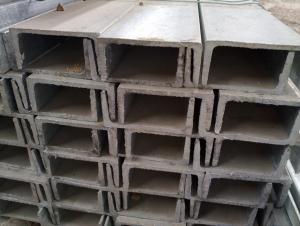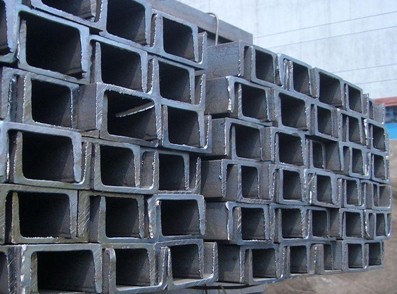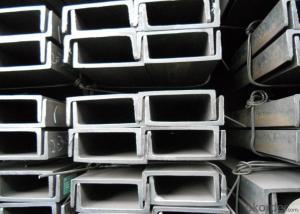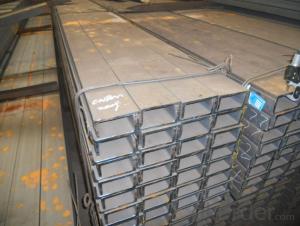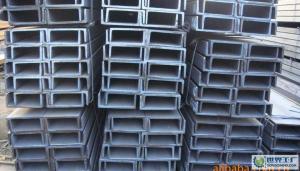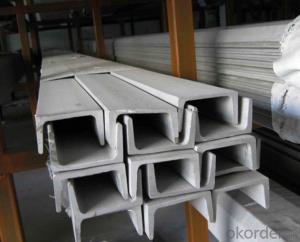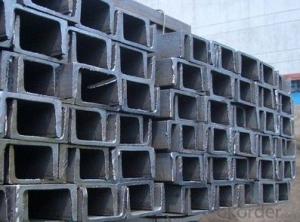CHANNEL JIS G3192 SS400 GB Q235 Q345 Hot Rolled
- Loading Port:
- China Main Port
- Payment Terms:
- TT or LC
- Min Order Qty:
- -
- Supply Capability:
- -
OKorder Service Pledge
OKorder Financial Service
You Might Also Like
Product Description:
OKorder is offering high quality CHANNEL JIS G3192 SS400 GB Q235 Q345 Hot Rolledat great prices with worldwide shipping. Our supplier is a world-class manufacturer of steel, with our products utilized the world over. OKorder annually supplies products to European, North American and Asian markets. We provide quotations within 24 hours of receiving an inquiry and guarantee competitive prices.
Product Applications:
1.The JIS U Channel Steel can be devided into two kinds, namely common channel steel and light channel steel. The sizes of hot rolled common channel steel range from 5# to 40#. Meanwhile, the channel steel can be divided into cold forming sectional equal channel steel, cold forming sectional unequal channel steel, cold forming inner edge channel steel and outer edge channel steel.
2.The JIS u channel steel is usually used for arch-itechtural structure, and they could be welded in order to support or hang a vari-ety of facilities. They are also usually used in combination with I beam. The channel steel with sizes under 14# is usually applied to construction engineering, as purline, while the channel steel with sizes above 16# is more likely to be used in building vehicle chassis structure and mechanical structure. Furthermore, the channel steel in sizes above 30# are target at building bridge structure, as tension bar.
Product Advantages:
OKorder's CHANNEL JIS G3192 SS400 GB Q235 Q345 Hot Rolled are durable, strong, and resist corrosion.
Main Product Features:
· Premium quality
· Prompt delivery & seaworthy packing (30 days after receiving deposit)
· Corrosion resistance
· Can be recycled and reused
· Mill test certification
· Professional Service
· Competitive pricing
Product Specifications:
Manufacture: Hot rolled
Grade: Q195 – 235
Certificates: ISO, SGS, BV, CIQ
Length: 6m – 12m, as per customer request
Packaging: Export packing, nude packing, bundled
Original Place | Tangshan, China | Brand Name | UINDA |
Standard | JIS G3192 : 1990 | ||
Material Grade | SS490 | ||
Sizes | 50mm to 200mm | ||
Sales Volume/Year | 3000MT | ||
Destination Area | Middle East, Africa, Southeast Asia | ||
2. The sections in details are as followings in the table-1
JIS U CHANNEL | Standard | Sectional | Dimension |
| Mass: |
| (mm) | (mm) | (mm) | (mm) |
|
50x25 | 50 | 25 | 3.0 | 6.00 | 2.37 |
75X40 | 75 | 40 | 3.8 | 7.00 | 5.30 |
75X40 | 75 | 40 | 4.0 | 7.00 | 5.60 |
75X40 | 75 | 40 | 4.5 | 7.00 | 5.85 |
75X40 | 75 | 40 | 5.0 | 7.00 | 6.92 |
|
|
|
|
|
|
100X50 | 100 | 50 | 3.8 | 6.00 | 7.30 |
100X50 | 100 | 50 | 4.2 | 6.00 | 8.03 |
100X50 | 100 | 50 | 4.5 | 7.50 | 8.97 |
100X50 | 100 | 50 | 5.0 | 7.50 | 9.36 |
|
|
|
|
|
|
125X65 | 125 | 65 | 5.2 | 6.80 | 11.66 |
125X65 | 125 | 65 | 5.3 | 6.80 | 12.17 |
125X65 | 125 | 65 | 5.5 | 8.00 | 12.91 |
125X65 | 125 | 65 | 6.0 | 8.00 | 13.40 |
|
|
|
|
|
|
150x75 | 150 | 75 | 5.5 | 7.30 | 14.66 |
150x75 | 150 | 75 | 5.7 | 10.00 | 16.71 |
150x75 | 150 | 75 | 6.0 | 10.00 | 17.90 |
150x75 | 150 | 75 | 6.5 | 10.00 | 18.60 |
150x75 | 150 | 75 | 6.5 | 10.00 | 24.00 |
|
|
|
|
|
|
200X80 | 200 | 80 | 7.5 | 11.00 | 24.60 |
3. The mechanical property of JIS U Channel Steel in the table-2:
Grade | Yield Strength,N/mm² | Extension Strength N/mm² | |||
Thickness of Steel,mm | |||||
≦16 | >16-≦40 | >40-≦100 | >100 | ||
SS490 | ≧285 | ≧275 | ≧255 | ≧245 | 490-610 |
4. The chemical composition of JIS U Channel Steel as per SS490 in the table-3
Grade | Element(%) | |||
C | Mn | P | S | |
SS490 | - | - | ≦0.050 | ≦0.050 |
FAQ:
Q1 How do we guarantee the quality of our products?
A1 We have established an advanced quality management system which conducts strict quality tests at every step, from raw materials to the final product. At the same time, we provide extensive follow-up service assurances as required.
Q2ow do you package the angle steel when shipping?
A2l goods are packed in bundles with steel strips and shipped by container or break bulk.
Q3What makes stainless steel stainless?
A3tainless steel must contain at least 10.5 % chromium. It is this element that reacts with the oxygen in the air to form a complex chrome-oxide surface layer that is invisible but strong enough to prevent further oxygen from "staining" (rusting) the surface. Higher levels of chromium and the addition of other alloying elements such as nickel and molybdenum enhance this surface layer and improve the corrosion resistance of the stainless material.
A5: Stainless does not "rust" as you think of regular steel rusting with a red oxide on the surface that flakes off. If you see red rust it is probably due to some iron particles that have contaminated the surface of the stainless steel and it is these iron particles that are rusting. Look at the source of the rusting and see if you can remove it from the surface.
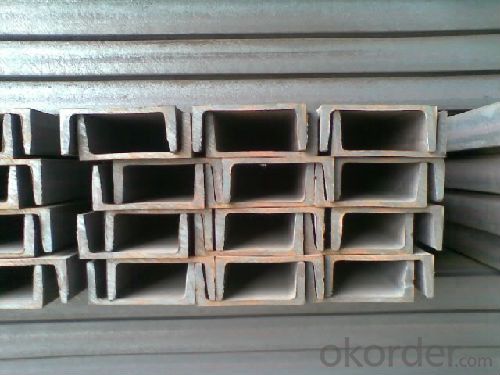
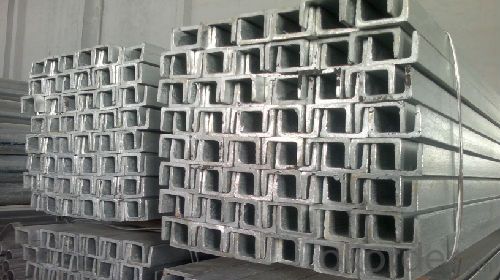
- Q: What are the different grades of steel used in channels?
- The different grades of steel used in channels can vary depending on the specific application and requirements. However, some commonly used grades include A36, A572, and A588. A36 steel is a low carbon steel that is commonly used in construction and structural applications. It has good weldability and machinability, making it suitable for various channels used in building projects. A572 steel is a high-strength, low-alloy steel that is often used in structural applications such as bridges, buildings, and machinery. It offers better strength and toughness compared to A36 steel, making it suitable for heavy-duty channels that require higher load-bearing capacity. A588 steel, also known as weathering steel, is a high-strength, low-alloy steel that is designed to withstand atmospheric corrosion. It is commonly used in outdoor applications such as bridges, buildings, and infrastructure. A588 channels are often used in coastal or harsh environmental conditions where corrosion resistance is crucial. Other grades of steel used in channels may include A992, A500, and A709, among others. Each grade has its own specific properties and characteristics, making it suitable for different types of channels based on the intended use and environmental factors.
- Q: Can steel channels be used in residential construction?
- Indeed, residential construction can incorporate steel channels. These steel channels, which possess a C-shaped cross-section, serve as structural supports made of steel. In the realm of building construction, they are widely utilized for the purpose of providing stability and support to diverse elements like walls, floors, and roofs. The utilization of steel channels in residential construction yields numerous benefits, including their exceptional strength-to-weight ratio, durability, and resistance to fire, rot, and pests. Moreover, they exhibit versatility and find usefulness in a range of applications such as framing, wall studs, and roof trusses. Furthermore, the adaptability of steel channels allows for easy customization and cutting to specific lengths, rendering them suitable for various building designs and requirements.
- Q: How do steel channels contribute to the overall speed of construction?
- There are several ways in which steel channels contribute to the overall speed of construction. To begin with, steel channels are prefabricated components that can be easily manufactured off-site and transported to the construction site. This eliminates the need for on-site fabrication, resulting in a significant reduction in construction time. Furthermore, steel channels possess the qualities of being lightweight yet strong, which makes them easy to handle and install. As a result, construction workers can quickly and efficiently assemble these components, saving both time and labor costs. Additionally, steel channels can be easily connected using various fastening methods such as welding or bolting, further expediting the construction process. Moreover, steel channels offer great flexibility in terms of design and can be easily modified or adjusted during construction. This adaptability allows construction projects to be completed at a faster pace, as changes can be made to the structure without causing significant delays or disruptions. Lastly, steel channels provide structural support and can be utilized in a variety of applications, including framing, bracing, and supporting heavy loads. Due to their high strength-to-weight ratio, they ensure the stability and durability of the construction, enabling faster progress without compromising safety. In summary, the inclusion of steel channels in construction plays a crucial role in speeding up the project by reducing fabrication time, facilitating quick assembly, accommodating design modifications, and offering structural support.
- Q: What are the guidelines for steel channel installations in seismic zones?
- To ensure the structural integrity and safety of buildings during seismic events, it is crucial to follow guidelines for steel channel installations in seismic zones. These guidelines are developed based on engineering principles, regulatory bodies, and industry standards. 1. Considerations for Design: When designing steel channel installations in seismic zones, it is important to consider seismic forces, building geometry, and structural connections. A qualified structural engineer should be responsible for the design, taking into account project-specific requirements. 2. Material Selection: It is recommended to use high-quality steel channels that meet the specifications outlined in relevant standards such as ASTM A36 or ASTM A572. Before installation, the channels should be inspected for defects. 3. Connection Details: Proper connection details are essential for withstanding seismic forces. Welding or bolting should be done following approved methods and standards. Connections should be designed to resist both vertical and lateral forces, ensuring overall structure stability. 4. Anchorage: Steel channel installations should be securely anchored to the building's foundation or structural system. Design specifications should dictate the use of anchor bolts or other approved anchorage methods capable of withstanding anticipated seismic forces. 5. Seismic Bracing: Additional bracing may be necessary in seismic zones to enhance the stability of steel channel installations. Diagonal braces or moment frames should be designed and installed to resist lateral forces. The bracing layout and connections should comply with relevant codes and standards. 6. Inspection and Quality Control: Qualified personnel should regularly inspect steel channel installations to ensure compliance with design specifications and codes. Quality control measures should be implemented to monitor the manufacturing, fabrication, and installation processes. 7. Compliance with Local Codes: Familiarity with and adherence to specific seismic design codes and regulations in the project's location is essential. Consultation with local building authorities is necessary to meet all applicable requirements. Ultimately, the guidelines for steel channel installations in seismic zones aim to create safe and resilient structures capable of withstanding seismic forces. Engaging the expertise of qualified professionals, such as structural engineers, is crucial to accurately follow the guidelines and meet necessary standards.
- Q: What are the different methods of strengthening steel channels against bending?
- There are several methods of strengthening steel channels against bending. One common method is to add additional material, such as angle iron or flat bars, to the flanges of the channel to increase their rigidity. Another approach is to increase the thickness of the channel itself, which helps to resist bending forces. Additionally, using bracing techniques, such as adding diagonal supports or cross-members, can enhance the overall strength and stability of the steel channel. Welding stiffeners or gussets to critical areas of the channel can also provide reinforcement against bending. Ultimately, the specific method chosen depends on the intended use and the level of bending resistance required for the steel channel.
- Q: Can steel channels be used for supporting walkways and platforms?
- Yes, steel channels can be used for supporting walkways and platforms. Steel channels are commonly used in construction projects for their strength and durability. They provide a solid and stable support structure, making them ideal for supporting walkways and platforms. Steel channels can be designed to meet specific load requirements and can be easily assembled to create a secure and reliable structure. Additionally, steel channels can be galvanized or coated for increased corrosion resistance, ensuring their longevity and safety.
- Q: How do steel channels perform in high-load applications?
- Steel channels perform exceptionally well in high-load applications due to their high strength and load-bearing capabilities. The design of steel channels allows for efficient distribution of weight, making them ideal for supporting heavy loads and withstanding significant stresses. The structural integrity of steel channels ensures that they can handle the demands of high-load applications without compromising safety or performance. Steel channels are commonly used in construction, automotive, and industrial sectors where there is a need to support heavy equipment, structures, or machinery. Their robustness and durability make them reliable and long-lasting, even under extreme conditions. Additionally, steel channels have excellent resistance to bending, twisting, and warping, making them suitable for withstanding dynamic loads and vibrations. Another advantage of steel channels in high-load applications is their versatility. They come in various sizes, shapes, and thicknesses, allowing engineers to select the most suitable channel for a specific application. This flexibility in design ensures an optimal fit for different load requirements, giving engineers the ability to optimize the load-bearing capacity while minimizing weight and material costs. Furthermore, steel channels have good corrosion resistance, especially when coated with protective treatments or finishes. This enables them to withstand harsh environmental conditions and maintain their performance over time. Additionally, steel channels can be easily welded, bolted, or fastened together, providing flexibility in construction and allowing for easy customization or modification as needed. In summary, steel channels are highly reliable and efficient in high-load applications. Their strong and durable nature, along with their versatility and resistance to bending and corrosion, make them an excellent choice for supporting heavy loads in various industries.
- Q: What are the standard sizes of steel channels?
- Steel channels come in a variety of standard sizes, which depend on the region and industry standards being followed. These sizes are designed to meet the different requirements of construction and engineering projects. Examples of common standard sizes include C3x4.1, C6x8.2, C8x11.5, C10x15.3, C12x20.7, C15x33.9, C18x54.7, C20x66.3, and so on. These sizes indicate the dimensions of the channel, such as its height, width, and weight per foot. It's worth noting that there might be slight variations in these sizes depending on the manufacturer or supplier. Therefore, it is advisable to refer to relevant industry standards or seek guidance from a professional engineer to determine the appropriate size of steel channels for a specific application.
- Q: How are steel channels protected against rusting and corrosion?
- Steel channels are protected against rusting and corrosion through various methods such as coating them with corrosion-resistant materials like zinc or paint, galvanizing them by applying a layer of zinc through a hot-dip process, or using stainless steel channels which have inherent resistance to rusting and corrosion.
- Q: Installation of floor type distribution box, foundation channel production and installation, the quota should choose which two?
- Floor type distribution box installation cannot apply the distribution cabinet installation, and should set floor type of distribution box installation quota; installation set foundation channel steel foundation channel steel installation item.
Send your message to us
CHANNEL JIS G3192 SS400 GB Q235 Q345 Hot Rolled
- Loading Port:
- China Main Port
- Payment Terms:
- TT or LC
- Min Order Qty:
- -
- Supply Capability:
- -
OKorder Service Pledge
OKorder Financial Service
Similar products
Hot products
Hot Searches
Related keywords
